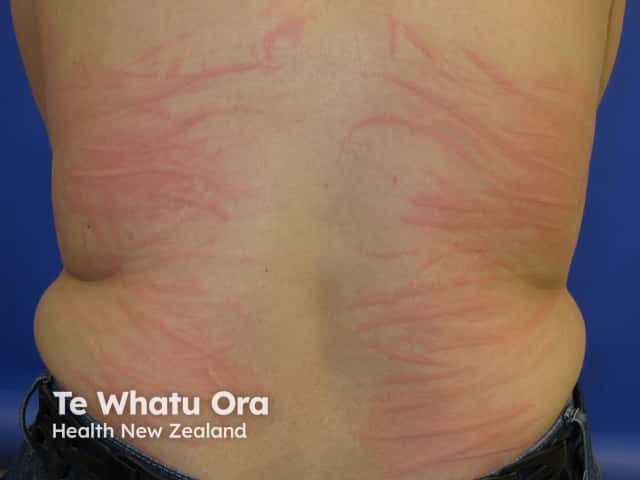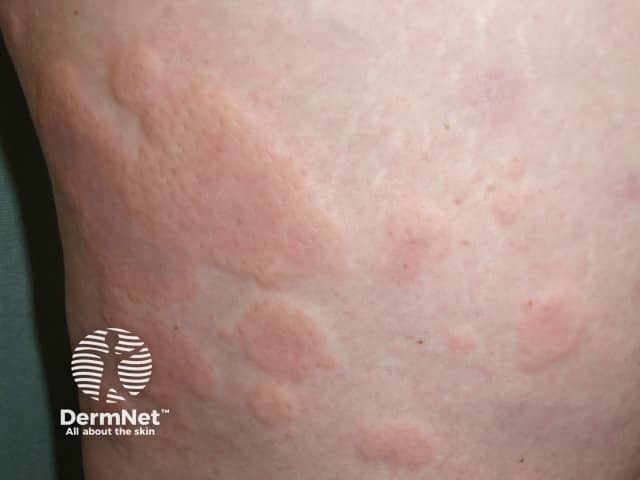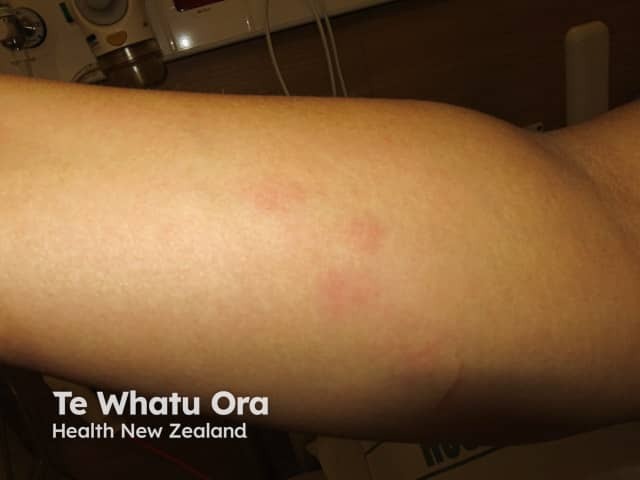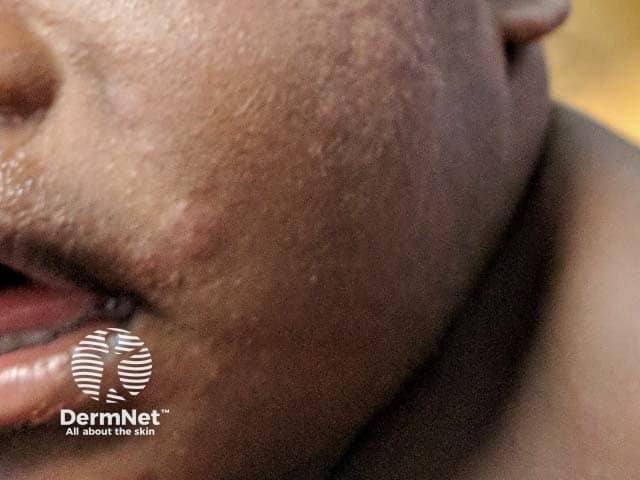Main menu
Common skin conditions

NEWS
Join DermNet PRO
Read more
Quick links
Chronic urticaria — extra information
Chronic urticaria
Author and DermNet Editor-in-Chief: Dr Amanda Oakley, Dermatologist, Hamilton, New Zealand, January 2015. DermNet Update April 2021
Introduction
Demographics
Causes
Clinical features
Diagnosis
Treatment
Outlook
What is chronic urticaria?
Chronic urticaria is defined as daily itchy wealing of the skin for more than six weeks. Chronic urticaria may be spontaneous or inducible, which may co-exist.

Dermographism: inducible urticaria

Spontaneous urticaria

Spontaneous urticaria
Who gets chronic urticaria?
Chronic urticaria can affect children and adults. Chronic inducible urticaria is more common than chronic spontaneous urticaria.
Adults with chronic urticaria have a significantly higher prevalence of atopic dermatitis, asthma, and allergic rhinitis than a control population. In children, the prevalence of atopy is similar in those with chronic urticaria as the general population.
Chronic spontaneous urticaria affects 0.5–2% of the population; in some series, two-thirds are women. There are genetic and autoimmune associations.
What causes chronic urticaria?
Weals are due to release of chemical mediators from tissue mast cells and circulating basophils. These chemical mediators include histamine, platelet-activating factor, and cytokines. The mediators activate sensory nerves and cause dilation of blood vessels and leakage of fluid into surrounding tissues. Bradykinin release causes angioedema.
Several hypotheses have been proposed to explain urticaria. The immune, arachidonic acid and coagulation systems are involved, and genetic mutations are under investigation, as are IL-4/-13 inhibitors such as dupilumab.
Chronic spontaneous urticaria
Chronic spontaneous urticaria is mainly idiopathic (cause unknown). An autoimmune cause is likely. About half of investigated patients carry functional IgG autoantibodies to immunoglobulin IgE or high-affinity receptor FcεRIα.
Chronic spontaneous urticaria has also been associated with:
- Chronic underlying infection, such as Helicobacter pylori, bowel parasites
- Chronic autoimmune diseases, such as systemic lupus erythematosus, thyroid disease, coeliac disease, vitiligo, and others
- Lymphoma.
Weals in chronic spontaneous urticaria may be aggravated by:
- Heat
- Viral infection
- Tight clothing
- Drug pseudoallergy — aspirin, nonsteroidal anti-inflammatory drugs, opiates
- Food pseudoallergy — salicylates, azo dye food colouring agents such as tartrazine (102), benzoate preservatives (210-220), and other food additives.
Chronic inducible urticaria
Chronic inducible urticaria is a response to a physical stimulus.
- Stroking or scratching the skin
- Tight clothing
- Towel drying after a hot shower
- Cold air on exposed skin
- Cold water
- Ice block
- Cryotherapy
- Sweat induced by exercise
- Sweat induced by emotional upset
- Hot shower
- Eliciting substance absorbed through the skin or mucous membrane
- Allergens (IgE-mediated): white flour, cosmetics, textiles, latex, saliva, meat, fish, vegetables
- Pseudoallergens or irritants: stinging nettle, hairy caterpillar, medicines
- Pressure on affected skin several hours earlier
- Carrying heavy bag
- Pressure from a seat belt
- Standing on a ladder rung
- Sitting on a horse
- Sun exposure to non-habituated body sites
- Often does not affect the face, neck, or hands
- May involve long-wavelength UV or visible light
- Hot water bottle
- Hot drink
- Jackhammer
- Hot or cold water
- Fresh, salt, or chlorinated water
Recurrent angioedema without urticaria can be due to inherited or acquired complement C1 esterase deficiency, or to the longterm use of an ACE inhibitor drug. [see ACE inhibitor-induced angioedema]
What are the clinical features of chronic urticaria?
Urticaria is characterised by weals.
- Weals can affect any site of the body and tend to be distributed widely.
- Weals can be a few millimetres or several centimetres in diameter.
- They can be coloured white or red, with or without a red flare.
- Each weal may last a few minutes or several hours and may change shape before resolving.
- Weals may be round, or form rings, a map-like pattern, or giant patches.
- Chronic urticaria describes transient weals coming and going for more than 6 weeks.

Urticaria

Urticaria in skin of colour

Urticarial rash in skin of colour
Angioedema is more often localised.
- It commonly affects the face (especially presenting as swollen eyelids and lips), hands, feet, and genitalia.
- It may involve tongue, uvula, soft palate, and larynx.
In chronic inducible urticaria, weals appear about 5 minutes after the stimulus and last a few minutes or up to one hour. Characteristically, weals are:
- Linear in dermographism
- Tiny in cholinergic urticaria
- Confined to contact areas in contact urticaria
- Diffuse in cold urticaria—if large areas of skin are affected, can lead to fainting (potentially dangerous if swimming in cold water).
The weals are more persistent in chronic spontaneous urticaria, but each has disappeared or has altered in shape within 24 hours. They may occur at certain times of the day.
Urticaria severity assessment
Visual analogue scales can be used to record and compare the degree of itch.
The activity of chronic urticaria can be assessed using the UAS7 scoring system. The daily weal/itch scores are added up for seven days; the maximum score is 42.
Score 0
- No weals for 24 hours
- No itch
Score 1
- < 20 weals during 24 hours
- Mild itch
Score 2
- 20–50 weals during 24 hours
- Moderate itch
Score 3
- > 50 weals during 24 hours
- Intense itch
The emotional impact of urticaria and its effect on the quality of life should also be assessed. The Dermatology Life Quality Index (DLQI) and CU-Q2oL, a specific questionnaire for chronic urticaria, have been validated for chronic urticaria, where sleep disruption is a particular problem.
Systemic symptoms in chronic spontaneous urticaria
Some patients with chronic spontaneous urticaria report associated systemic symptoms. These include:
- Headache and fatigue
- Joint pain or swelling
- Wheezing, flushing and palpitations
- Gastrointestinal symptoms.
How is chronic urticaria diagnosed?
Chronic urticaria is diagnosed in people with a long history of daily or episodic weals that last less than 24 hours, with or without angioedema. A medication and family history should be elicited. A thorough physical examination should be undertaken to evaluate the cause.
Inducible urticaria is often confirmed by inducing the reaction, such as scratching the skin in dermographism or applying an ice cube in suspected cold urticaria.
Suggested investigations for chronic spontaneous urticaria:
- Full blood examination
- ESR or C-reactive protein
- Liver enzymes
- Renal function
- Thyroid test - TSH
Further investigations should only be undertaken if an underlying disorder is suspected on history and examination.
- Investigations for H. pylori infection.
- Tryptase.
- Autoantibody screening.
- The autologous serum skin test is sometimes carried out in chronic spontaneous urticaria, but its value is uncertain. It is positive if an injection of the patient's serum under the skin causes a red weal.
- Investigations for a systemic condition or autoinflammatory disease should be undertaken in urticaria patients with fever, joint or bone pain, and malaise.
- Patients with angioedema without weals should be asked if they take ACE–inhibitor drugs and should be tested for complement C4; C1-INH levels, function and antibodies; and C1q.
- Biopsy of urticaria can be non-specific and difficult to interpret. The pathology shows oedema in the dermis and dilated blood vessels, with a variable mixed inflammatory infiltrate. Vessel-wall damage indicates urticarial vasculitis.
What is the treatment for chronic urticaria?
Antihistamines
The main treatment for chronic urticaria in adults and children is with an oral second-generation H1-antihistamines such as cetirizine or loratidine. If the standard dose (eg, 10 mg for cetirizine) is not effective, the dose can be increased fourfold (eg, 40 mg cetirizine daily). The addition of a second antihistamine is not thought to be helpful.
Terfenadine and astemizole should not be used as they are cardiotoxic in combination with ketoconazole or erythromycin. They are no longer available in New Zealand.
Although systemic treatment is best avoided during pregnancy and breastfeeding, there have been no reports that second-generation antihistamines cause birth defects. If treatment is required, loratadine and cetirizine are currently preferred.
Conventional first-generation antihistamines such as promethazine or chlorpheniramine are no longer recommended for chronic urticaria.
Avoidance and treatment of triggers
Identifiable triggers for urticaria should be avoided where possible. For example:
- Treat identified chronic infections such as H pylori.
- Avoid aspirin, opiates, and nonsteroidal anti-inflammatory drugs (paracetamol is generally safe).
- Minimise dietary pseudoallergens for a trial period of at least three weeks.
- Avoid known allergies that have been confirmed by positive specific IgE/skin prick tests if these have clinical relevance for urticaria.
- Cool the affected area with a fan, cold flannel, ice pack, or soothing moisturising lotion.
The physical triggers for inducible urticaria should be minimised; see examples below. However, symptoms often persist.
- Reduce friction in dermographism and avoid tight clothing.
- Dress warmly in cold or windy conditions and avoid swimming in cold water in cold urticaria.
- Broaden the contact area, for example, with a heavy bag in delayed pressure urticaria.
- Dress up and use broad-spectrum sunscreens in solar urticaria.
Some patients with inducible urticaria benefit from daily induction of symptoms to induce tolerance. Phototherapy may be helpful for symptomatic dermographism.
Treatment of chronic refractory urticaria
Patients with chronic urticaria that has failed to respond to maximum-dose second-generation oral antihistamines taken for four weeks should be referred to a dermatologist, immunologist, or medical allergy specialist.
Omalizumab is now regarded as the treatment of choice for antihistamine-resistant patients. Ciclosporin is a fourth-line option. Remibrutinib and fenebrutinib, promising novel BTK inhibitors, are currently under investigation, as are IL-4/-13 inhibitors such as dupilumab.
Long-term systemic corticosteroids are not generally recommended, as high doses are often required to control symptoms of urticaria and they have inevitable adverse effects that can be serious. However, a study published in 2017 reported effective clearance and a long-lasting response of autoimmune chronic urticaria to low-dose oral prednisolone for several months.
What is the outlook for chronic urticaria?
The natural history of chronic spontaneous urticaria in children and adults is the same, with the chance of remission within three years being 30-50% and after five years 40-70%.
Chronic inducible urticaria seems to be more persistent, particularly cold urticaria and solar urticaria.
Bibliography
- Bracken SJ, Abraham S, MacLeod AS. Autoimmune theories of chronic spontaneous urticaria. Front Immunol. 2019;10:627. doi:10.3389/fimmu.2019.00627. Journal
- Caffarelli C, Paravati F, El Hachem M, et al. Management of chronic urticaria in children: a clinical guideline. Ital J Pediatr. 2019;45(1):101. doi:10.1186/s13052-019-0695-x. Journal
- Jáuregui I, Ortiz de Frutos FJ, Ferrer M, et al. Assessment of severity and quality of life in chronic urticaria. J Investig Allergol Clin Immunol. 2014;24(2):80–6. Journal
- Kolkhir P, Altrichter S, Munoz M, Hawro T, Maurer M. New treatments for chronic urticaria. Ann Allergy Asthma Immunol. 2020;124(1):2–12. doi:10.1016/j.anai.2019.08.014. Journal
- Maurer M, Berger W, Giménez-Arnau A, et al. Remibrutinib, a novel BTK inhibitor, demonstrates promising efficacy and safety in chronic spontaneous urticaria [published correction appears in J Allergy Clin Immunol. 2023 Feb;151(2):579]. J Allergy Clin Immunol. 2022;150(6):1498-1506.e2. doi:10.1016/j.jaci.2022.08.027 Journal
- Vas K, Altmayer A, Mihályi L, et al. Successful treatment of autoimmune urticaria with low-dose prednisolone therapy administered for a few months: a case series of 42 patients. Dermatology. 2017;233(6):419–24. doi:10.1159/000484085. PubMed
- Westby EP, Lynde C, Sussman G. Chronic urticaria: following practice guidelines. Skin Therapy Lett. 2018;23(3):1–4. Journal
On DermNet
- Acute urticaria
- Chronic spontaneous urticaria
- Chronic inducible urticaria
- Angioedema
- Anaphylaxis
- Urticaria-like conditions
- Food allergy
- Contact urticaria
- Cholinergic urticaria
- Cold urticaria
- Drug-induced urticaria
- Heat urticaria
- Dermographism
- Pressure urticaria
- Solar urticaria
- Pressure urticaria
- Vibratory angioedema
- Vibratory urticaria
- Serum sickness
- Serum sickness-like reactions
- Dermatological emergencies online course
- Autologous serum skin testing
- Exercise-induced anaphylaxis
- Skin signs of rheumatic disease
Other websites
- Hives — MedlinePlus
- Urticaria and Angioedema — British Association of Dermatologists
